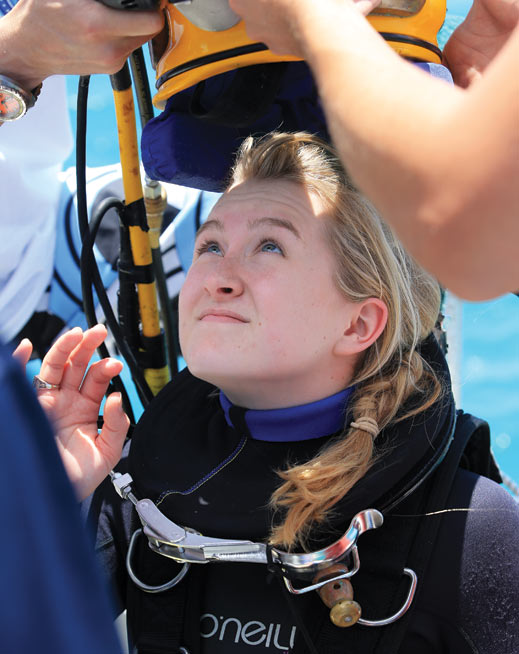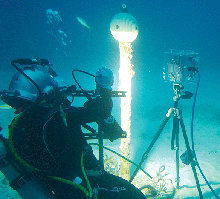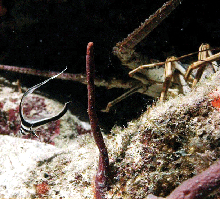Grace Undersea
Flipping my brass rat on the floor of the Atlantic wasn’t in my initial graduation plans. But when Fabien Cousteau, grandson of the famed underwater explorer Jacques Cousteau, invited me to join Mission 31 as an aquanaut and mission scientist in the underwater habitat Aquarius, I couldn’t pass up the chance. His idea was to break his grandfather’s 30-day record of living underwater to conduct intensive research on marine ecosystems—and to educate millions around the world about the critical need to protect our oceans. Even though it meant missing commencement with my classmates to train for the mission, I leaped at the opportunity to follow in the oversized footsteps of the late Professor Harold “Doc” Edgerton, SM ’27, ScD ’31, Jacques Cousteau’s close collaborator on so many of his undersea adventures.

Built in the 1980s and bolted to the seabed 63 feet below the surface off the Florida Keys, Aquarius is the world’s only underwater marine laboratory. The inside air pressure matches the outside atmospheric pressure at that depth (2.6 atmospheres, as opposed to the standard one atmosphere at sea level and in a submarine), so our bodies were saturated with nitrogen. This allowed us to dive for essentially as long as we wanted, whereas on a normal surface dive you can only spend about an hour at that depth without risking decompression sickness. The added time let us conduct research in a month that would have taken about two years if we were diving from the surface.

There was plenty to do. During my 15-day stint on Aquarius, I worked alongside Cousteau and fellow researchers from Northeastern University and Florida International University (plus a film crew and habitat technicians) to investigate such things as the health of coral reefs, the metabolism of sponges, the circadian rhythms of zoöplankton, and potential underwater uses of new technologies like the Edgertronic high-speed camera. Our research will help elucidate the effects of climate change, increased acidification, and industrial and agricultural pollution—and could ultimately help scientists figure out how to fix things before it’s too late.
Going Under
As my last semester at MIT was drawing to a close, I headed to Florida for two weeks of intensive aquanaut training from Navy instructors before splashdown. The experience was not unlike astronaut training, although it included scuba skills checks in addition to fitness tests and medical exams. We also learned how to use special equipment required for the mission, such as dive helmets and double tanks of compressed air. By the time I descended Aquarius on June 17, emergency procedures for every imaginable situation were ingrained as muscle memory.
Aquarius, our home undersea, is only slightly larger than a school bus. It was cozy, to say the least. Inside it looked and felt like a combination of the International Space Station and an RV. Its mini-kitchen was equipped with a microwave, sink, and hot water dispenser. But because air in the habitat had 2.6 times the oxygen of surface air, fresh food spoiled fast and cooking with an open flame was unthinkable. We mostly ate freeze-dried food (think astronaut food), which was convenient, quick, and easy to store. Occasionally we’d get special food “potted” down to us in a pressurized steel container if the surface team thought we needed a treat. When Celine Cousteau (Fabien’s sister and a noted explorer and conservationist in her own right) visited us, she brought a fresh baguette and cheese that we inhaled long before she had to return to the surface.
Valves and gauges adorned almost every surface of the habitat, whose air, power, and IT link are supplied via what’s known as an umbilical connected to a buoy. Sliding sealed doors divided the bunk room, the eating area, the work space, the tiny bathroom, and the “wet porch” containing the hole in the floor that served as the entryway. (To envision the wet porch, imagine a bucket flipped upside down and pushed underwater so it’s trapping an air pocket. The inside air pressure kept water out, and we would cross the horizontal boundary between air and water to enter the ocean.) My favorite spot was our little dining table in front of the view port, where so many beautiful sea creatures attracted by the light would visit us.

A surface team of 24 specialists kept us safe and well undersea, including a Navy doctor who regularly checked our health. Fortunately, the worst ailment any of us suffered was an ear infection, which is common when spending so much time in the water.
On most days, we were up by 7:00 a.m. and out on our first dive by 8:00. We typically dove three times a day for a total of six to 10 hours, collecting zoöplankton samples, receiving and installing sensors to collect data on contaminants, and working with the Edgertronic camera. Although I was principally responsible for the camera, I had a lot of support from the Edgerton Center’s Jim Bales, PhD ’91, in Cambridge, and capturing the best image took three of us on site—one to manage the camera position, one to adjust lighting, and one to look at the detailed image and control settings from inside the habitat. The camera records images of things that happen in the blink of an eye, but it requires hours to set up and operate underwater, so it can be used only by saturated aquanauts.
One of the most intriguing things we tried to capture was the source of the booming sound that a Goliath grouper makes when it feeds. Northeastern professor Mark Patterson has theorized that the fish rapidly expands its mouth, causing a sudden decrease in pressure—known as a cavitation bubble—that instantly vaporizes the water it’s holding. When the bubble collapses, it makes a sound that divers can feel in their chests—a sound that seems to stun fish in the vicinity, making them easier prey. We knew that filming a cavitation bubble would require a great deal of luck under the best of circumstances, but it was especially ambitious given that we were working with such new filming technology (our Edgertronic model, which was designed by Mike Matter ’84, came out just two weeks before training started). Although we weren’t able to do it, we did figure out the steps required—and I’d love to get back down there to finish the project someday.

We did, however, manage to get incredible footage of mantis shrimp, coral, giant barrel sponges, lizardfish, plankton, and other marine creatures that had never been filmed in slow motion in the wild, capturing behavior that’s too fast for the human eye to see. Much of the footage will appear in an IMAX documentary Cousteau will release in 2015. Between our morning and afternoon dives, we’d come back to Aquarius for lunch and work on tasks like Skype talks with museums and school groups around the world. Our goal was to educate people about how important ocean exploration and conservation are and why we must stop destroying the environment upon which our life depends. Most people don’t realize that the oceans produce up to 70 percent of our oxygen, serve as the primary source of animal protein for at least a billion people, and filter or store toxins that would otherwise overwhelm humanity. Yet in the last 50 years we’ve overexploited—or in some cases entirely depleted—as much as 90 percent of large ocean fish and destroyed ecosystems that are fundamental to our own survival. Without the oceans, Earth is just another rock in space. Yet we know more about the dark side of the moon than we do about the bodies of water that cover two-thirds of our own planet. It’s very difficult, if not impossible, to fix problems we know little about, and yet an astonishing 95 percent of our oceans remain unexplored.
Marine Life
Fabien brought a deck of cards and never opened it in 31 days. Honestly, we didn’t have any spare time. Diving all day is exhausting, and back in Aquarius, we were busy communicating with the topside crew and doing outreach. If I had any kind of break, I’d usually go for another dive. It’s hard to describe the feeling of living in an entirely foreign ecosystem, mingling peacefully with so many beautiful sea creatures. You don’t want to waste a minute.

It’s also hard to convey how intellectually exhilarating the mission was. The entire team—including several dozen onshore research scientists, technicians, surface divers, and other support staff as well as periodic visitors—developed an incredible camaraderie. Each new discovery seemed to lead to new research ideas.
Surfacing was bittersweet. As much as I missed family, friends, and a long shower, I would have stayed down for at least another couple of weeks if given the chance. I can definitely see having a undersea vacation home someday. In the meantime, would I return to Aquarius if I had the opportunity? In a heartbeat.
Grace Young ’14, who majored in mechanical and ocean engineering, is a Marshall scholar and PhD candidate at Oxford’s Somerville College, where the Global Ocean Commission is headquartered.
Mission 31 Research
Coral reef health: Fundamental to one-third of all marine species, coral reefs are also critical to supporting human life. Yet acidification from carbon emissions and other pollutants threatens or has already destroyed 70 percent of them. We collected the first long-term data on how wild corals respond to daily fluctuations in external temperature, light, pH, and dissolved oxygen. Pinpointing the cause and effect of coral’s deterioration should help scientists design and implement remediation measures.
Zoöplankton: Marine life as we know it depends on zoöplankton. These tiny organisms are the first link in the marine food chain. Bacteria also attach themselves to zoöplankton’s exoskeletons. This creates a reservoir that prevents the spread of disease to humans and allows the bacteria to consume carbon and nitrogen from the ocean, a process that’s essential to a healthy planet. By collecting samples throughout the day—both live and “zombie” (recently dead but not yet broken down or consumed)—we compiled an enormous amount of data that will help us understand their circadian rhythm, their life cycle, and the effects of pollution and climate change on their health.
Barrel sponges:
As sponges feed, they filter water equal to their body volume in less than a minute, removing more than 99 percent of the particles they inhale. That prodigious filter feeding is one reason visibility is so good around a coral reef. We used sensors to measure fluctuations in temperature, salinity, pH, dissolved oxygen, and water flow to study how the sponges’ metabolism and feeding rate respond to changes in the environment.
Environmental contamination:
We deployed tiny sensors around Aquarius to absorb and measure pollution, including PCBs and possibly dispersants from the BP oil spill, to determine what contaminants are affecting the coral reef and how.
Keep Reading
Most Popular
Large language models can do jaw-dropping things. But nobody knows exactly why.
And that's a problem. Figuring it out is one of the biggest scientific puzzles of our time and a crucial step towards controlling more powerful future models.
How scientists traced a mysterious covid case back to six toilets
When wastewater surveillance turns into a hunt for a single infected individual, the ethics get tricky.
The problem with plug-in hybrids? Their drivers.
Plug-in hybrids are often sold as a transition to EVs, but new data from Europe shows we’re still underestimating the emissions they produce.
Stay connected
Get the latest updates from
MIT Technology Review
Discover special offers, top stories, upcoming events, and more.